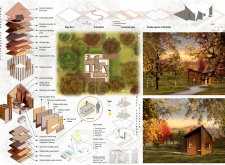5 key facts about this project
The primary function of the project is to serve as a versatile dwelling that accommodates diverse lifestyle needs. The design incorporates a range of spaces, including communal living areas, private retreats, and areas designated for food production. These spaces are organized to promote interaction among occupants while allowing for privacy when needed. The thoughtful arrangement of functional areas enhances the living experience, making it suitable for families and individuals alike.
The use of numerous sustainable and innovative materials distinguishes this project from conventional residential designs. The exterior features wooden shingles made of larch wood, which provides durability and insulation. Photovoltaic panels are extensively used, harnessing solar energy to power the home and reduce dependence on non-renewable resources. Additionally, the incorporation of wooden cross-laths ensures effective ventilation, further minimizing energy consumption.
Unique design approaches are evident in the emphasis on flexibility within the living spaces. The inclusion of sliding walls allows for the adaptation of interior layouts based on daily activities. The use of dual-functional furniture maximizes usability, accommodating various functions within a limited footprint. This adaptability reflects a growing trend in architecture toward multifunctional spaces that cater to the dynamic needs of modern life.
Another significant aspect of this project is the hydronic farming system integrated into the adjustable flooring. This innovative feature enables residents to engage in food production directly within their home, fostering a connection to sustainable living practices and self-sufficiency. The project exemplifies adaptability not only in spatial arrangement but also in promoting urban agriculture, an important consideration in contemporary architectural thinking.
For further exploration of the project's architectural plans, sections, designs, and ideas, readers are encouraged to delve into the project presentation. Detailed visual representations and technical specifications will provide deeper insights into the design's implementation and functionality.























